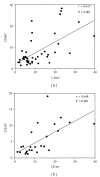Alterations in monocyte CD16 in association with diabetes complications
- PMID: 23316106
- PMCID: PMC3536440
- DOI: 10.1155/2012/649083
Alterations in monocyte CD16 in association with diabetes complications
Abstract
Monocytes express many cell surface markers indicative of their inflammatory and activation status. Whether these markers are affected by diabetes and its complications is not known and was investigated in this study. Blood was obtained from 22 nondiabetic and 43 diabetic subjects with a duration of diabetes >10 years, including 25 without and 18 with clinically significant complications. The number of CD45(+)CD14(+) monocytes and the percentage expressing the proinflammatory marker CD16 were determined by flow cytometry. Other markers of monocyte activation and expression of chemokine receptors were also examined. The relationship between monocyte CD16 and clinical data, selected cytokines, and chemokines was also investigated. Diabetes had no effect on total white cell number but increased monocyte number. Diabetes also significantly decreased the number of CD16(+) monocytes but only in those with diabetic complications. Other markers of monocyte activation status and chemokine receptors were not affected by diabetes or complications status. Diabetes induced plasma proinflammatory cytokines and they were lower in diabetic subjects with complications compared to those without complications. These results suggest that the circulating monocyte phenotype is altered by diabetic complications status. These changes may be causally related to and could potentially be used to predict susceptibility to diabetic complications.
Figures




Similar articles
-
CD16(+) monocyte subsets are increased in large abdominal aortic aneurysms and are differentially related with circulating and cell-associated biochemical and inflammatory biomarkers.Dis Markers. 2013;34(2):131-42. doi: 10.1155/2013/836849. Dis Markers. 2013. PMID: 23348634 Free PMC article.
-
HIV-infected cannabis users have lower circulating CD16+ monocytes and IFN-γ-inducible protein 10 levels compared with nonusing HIV patients.AIDS. 2018 Feb 20;32(4):419-429. doi: 10.1097/QAD.0000000000001704. AIDS. 2018. PMID: 29194121 Free PMC article.
-
CD16-expressing monocytes correlate with arterial stiffness in HIV-infected ART-naïve men.HIV Clin Trials. 2018 Apr;19(2):39-45. doi: 10.1080/15284336.2018.1437863. HIV Clin Trials. 2018. PMID: 29770747
-
Association between P-selectin glycoprotein ligand-1 and pathogenesis in acute coronary syndrome assessed by optical coherence tomography.Atherosclerosis. 2014 Apr;233(2):697-703. doi: 10.1016/j.atherosclerosis.2013.12.052. Epub 2014 Jan 28. Atherosclerosis. 2014. PMID: 24583418
-
CD14+,CD16+ blood monocytes and joint inflammation in rheumatoid arthritis.Arthritis Rheum. 2002 Oct;46(10):2578-86. doi: 10.1002/art.10545. Arthritis Rheum. 2002. PMID: 12384915
Cited by
-
Monocytes expand with immune dysregulation and is associated with insulin resistance in older individuals with chronic HIV.PLoS One. 2014 Feb 27;9(2):e90330. doi: 10.1371/journal.pone.0090330. eCollection 2014. PLoS One. 2014. PMID: 24587328 Free PMC article.
-
Vitamin D3 attenuates oxidative stress and regulates glucose level and leukocyte count in a semi-chronic streptozotocin-induced diabetes model.J Diabetes Metab Disord. 2021 May 20;20(1):771-779. doi: 10.1007/s40200-021-00814-2. eCollection 2021 Jun. J Diabetes Metab Disord. 2021. PMID: 34178862 Free PMC article.
-
The Functions of SARS-CoV-2 Receptors in Diabetes-Related Severe COVID-19.Int J Mol Sci. 2024 Sep 5;25(17):9635. doi: 10.3390/ijms25179635. Int J Mol Sci. 2024. PMID: 39273582 Free PMC article. Review.
-
Quantitative whole-cell MALDI-TOF MS fingerprints distinguishes human monocyte sub-populations activated by distinct microbial ligands.BMC Biotechnol. 2015 Apr 11;15:24. doi: 10.1186/s12896-015-0140-1. BMC Biotechnol. 2015. PMID: 25887592 Free PMC article.
-
Monocyte subtype expression patterns in septic patients with diabetes are distinct from patterns observed in obese patients.Front Med (Lausanne). 2023 Jan 5;9:1026298. doi: 10.3389/fmed.2022.1026298. eCollection 2022. Front Med (Lausanne). 2023. PMID: 36687421 Free PMC article.
References
-
- DCCT. Clustering of long-term complications in families with diabetes in the diabetes control and complications trial. The Diabetes Control and Complications Trial Research Group. Diabetes. 1997;46(11):1829–1839. - PubMed
-
- AUSO. Intensive blood-glucose control with sulphonylureas or insulin compared with conventional treatment and risk of complications in patients with type 2 diabetes (UKPDS 33) Lancet. 1998;352(9131):837–853. - PubMed
-
- Stitt AW, Jenkins AJ, Cooper ME. Advanced glycation end products and diabetic complications. Expert Opinion on Investigational Drugs. 2002;11(9):1205–1223. - PubMed
-
- Devaraj S, Glaser N, Griffen S, Wang-Polagruto J, Miguelino E, Jialal I. Increased monocytic activity and biomarkers of inflammation in patients with type 1 diabetes. Diabetes. 2006;55(3):774–779. - PubMed
-
- Tesch GH. Role of macrophages in complications of type 2 diabetes. Clinical and Experimental Pharmacology and Physiology. 2007;34(10):1016–1019. - PubMed
Publication types
MeSH terms
Substances
LinkOut - more resources
Full Text Sources
Medical
Research Materials
Miscellaneous

